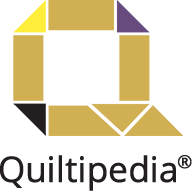What is Quilt Fabric?
Quilt Fabric is 100% cotton material created for making quilt tops and backs. At times you may see the "same" fabric with drastic price differences and will need a closer look. Thread count, the Staple Length of the cotton fibers, weave, printing and finishing are all components of high quality Quilt Fabric and add to the price and longevity of finished quilts.
Quilt cotton fabric thread count will vary between good quality at 60 to 75 threads per inch to high quality with 200 threads per inch in the length (warp) and width (weft). Batik fabric uses 200 to 220 thread count and a finer thread as required for the wax and dye process. The weight of the thread used should also be considered. Thread count is not generally shown on the bolt of cotton so hold the fabric up to the light: if you can easily see through it, it probably has a lower thread count.
Quilt Fabric is generally made of long staple cotton, meaning the length of the cotton fiber is 1 3/8" or 3.5 cm long or longer. Long staple cottons may be labeled as Pima or Egyptian and are stronger, more uniform than other cotton fibers and leave less lint in your sewing machine. Upland cotton, used for Flannel and Denim, has a staple length of less than 1 1/4" or 3.2 cm. However, both fabrics have their place in our stashes.
Quilt Fabric weave is generally a plain weave or even weave. The number of threads for the length (warp) and width (weft) are the same. This ensures the fabric will handle well and not fray during sewing and quilting. Quilt Fabrics are also being made with different color threads on the warp and weft, so the color will shimmer and move based on how the light falls. Different weaving patterns will also add interest to fabrics for quilting.
Printing Quilt Fabric for premium brands will have a higher number of colors used in the printing process. Take a look at the selvage, often you will see color dots or symbols that indicate all of the colors used to create the print. A High number of prints and complex designs are highly sought after by quilters and most often used as Focus Fabrics.
Finishing Quilt Fabric is an important step. High quality Quilt Fabric will feel soft, shrink less and have a superior colorfastness.
Using Quality Cotton Quilt Fabric is where most quilters start, but there are many options and directions today's quilters can go. Key considerations for selecting fabric for your next quilt are: How will the quilt be used? Will it hang on the wall, be a keepsake or used very day? Does the style of the quilt lend itself to other fabrics like linen or silk? What's the best fabric I can use right now? Rember the objective is to make a quilt!
Benefits of Quilt Fabric
- Making a quilt takes time, effort and should be an enjoyable experience, so using quality quilt fabric is important.
- Quilt Fabric is made in a weight and weave that is excellent for piecing precise blocks and quilt tops. Loosely woven or heavy weight fabrics are difficult to work with and will not hold up over time.
- Quality Quilt Fabric will have less shrinkage than other cotton fabrics.
- Quality Quilt Fabric is properly finished to improve colorfastness.
- Quilt Fabric is most often found in Quilt Shops and from online vendors who specialize in quilting supplies from reputable Quilt Fabric Manufacturers.
Supplies and Tools - Quilt Fabric
- Using high quality Quilt Fabric will result in a well made quilt that last a long time.
- To Wash or Not? This is a long standing debate amoung quilters. Some quilters always wash their fabric to ensure it is colorfast, will shrink no further and remove any added chemicals. Some quilters like the sizing and rely on the manufacturer for colorfastness, expect the shrinking will be the same for all the fabrics in the quilt and the chemicals are there instead of starch or sizing. The choice is yours to make.
What I Wished I Knew When I Started - Quilt Fabric
Not all Quilt Fabric is the same. Lesser quality fabric will not hold up over time and may not be as easy to work with. With experience, the quiltmaker will be able to recognize high quality Quilt Fabric. Test colorfastness with a damp white paper towel layed over the fabric, give it a squeeze and if there is color on the paper towel, wash the fabric.









